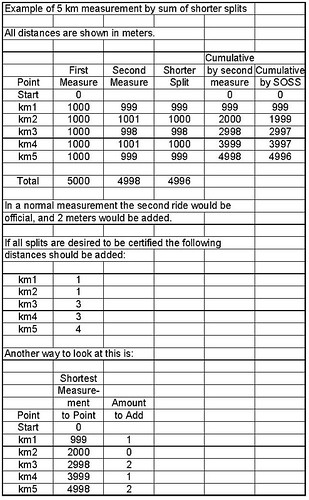Dear Pete,
On the advice of Paul Hronjak, I would like to post the following
comment on the RRCA bulletin board. Can you tell me how to do this?
Sincerely,
Tomas de Paulis, course measurer.
Sum of Shortest Splits (SOSS).
Recently, I have encountered SOSS as a method for obtaining an
accurate course distance. After looking into the statistical
significance of correcting a course with SOSS in addition to the
standard use of longest measurement, etc, I came to the conclusion
that SOSS should never be used to correct a course distance. The
reason is, that unless the splits are part of the certification, the
number of splits is an arbitrary number and their deviations from
the "correct" value is therefore irrelevant for the total course
length. I postulate that all courses that have been certified with an
SOSS correction are in fact erroneous in length.
My questions to you certifiers out there is, how did this idea come
about and what is the scientific rationale for using SOSS?
To illustrate my point, let's assume that the first mile split is
measured 10 feet too long on the first ride. Then on the second ride
it is measured correct but the second mile is measured 10 feet too
short. Both rides would have the same total distance. Now, because
the sum of shortest splits is 20 feet, this distance would have to be
added to the course, making it 20 feet in error! This argument holds
true for any deviation of the splits.
From Pete: Tomas, an example is shown below. Commentary is invited.

In the above, you would use the first method if you wanted to start at any split point and run a certified distance to another, such as on a bike path where every mile is marked. The second approach would be used if the start point was always the start line.
Note: To make posts on this bulletin board you must be registered.
